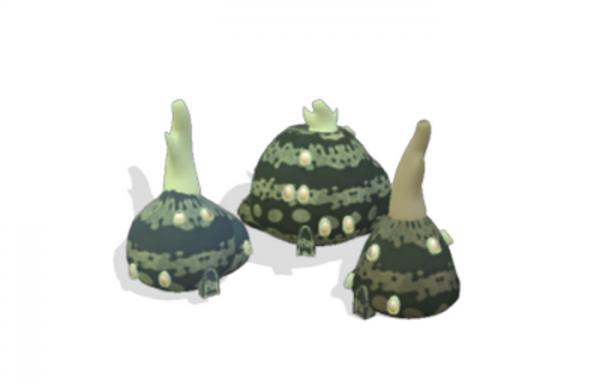BY LETTER
Gourd Houses
Technology > Application > Agriculture
Technology > Application > Construction
Technology > Application > Envirotech
Technology > Application > Everydaytech
Technology > Technology Type or Material > Gengineering
Technology > Technology Levels > High Tech / Hitech
Technology > Technology Type or Material > Organic/Biotech
Technology > Application > Construction
Technology > Application > Envirotech
Technology > Application > Everydaytech
Technology > Technology Type or Material > Gengineering
Technology > Technology Levels > High Tech / Hitech
Technology > Technology Type or Material > Organic/Biotech
A biotech house grown from a vine-like plant |
 Image from Mark Ryherd |
Peter Peter pumpkin eaterThis old meme may very well have been the inspiration for the gourd house. During the first century a.t. (or possibly the next) a revolution in biotech was occurring on Old Earth and people were looking to the new gengineering to solve old problems. One of these problems was housing for the multitudes of homeless that occupied even the wealthiest of countries and those persons who had been displaced by wars and climate change across the world.
had a wife and couldn't keep her.
He put her in a pumpkin shell
and there he kept her very well.
The gourd house was a very simple example of biotech, crudely done but ultimately very utile. The gourd house was little more than a giant, hollow, woody shell grown on a ground-hugging vine. In this respect the habit of the gourd house plant was similar to that of a pumpkin; in fact the original genestock was modified from various members of the cucurbitae family. However, unlike a pumpkin, the gourd had no internal flesh except for a .5-1 meter thick layer of spongy material lining the shell with a handful of seeds embedded in it. This material was soft and light, much like cork or balsa wood and could be easily carved out into useful shapes, even when only stone tools were available. The gourd grew without windows or doors but and these could be cut out as needed once the shell had hardened. The stem could also be removed after it dried to leave a 2m wide opening but because it too was hollow it was more often left in place to serve as a flue for whatever cooking or heating appliance was installed. Because it was, for all intent, simply an empty shell it could grow quickly once the vine had matured and in good soil with plenty of water a gourd would reach its maximum size of 10m across in about a year but most were harvested before they reached that size. If left alone a gourd grew into a dome shape under the pressure of oxygen gas released inside. (The genes for the plant were actually for a spherical shell but its weight forced the bottom to be flattened against the ground as it grew to larger sizes.) However many were instead 'trained' while growing into more convenient shapes; one popular shape was a 3m wide cylinder that could be easily transported by a flatbed truck, open railcar or large cargo plane. The gourds could also float unaided, which gave them yet another means to be brought into an area that needed them. Or they could be trained into less convenient shapes; gourd house owners were often touched by a sense of whimsy and on more than one occasion a gourd house was trained into a squat sphere with vertical ribs while the windows and doors were cut out to resemble a Jack-o-lantern.
Natural chemicals in the wood of the gourd gave it protection from fire, rot and insect pests and when the shell was dried it was strong enough that it could be buried under ground for extra protection in more extreme climates. Burying a gourd house also gave the residents a way to plant a garden for food above their new home with no additional allocation of land. On the other hand, when buried at the right depth and properly resealed, the cooler temperature of the ground and low oxygen levels inside could act to keep grain or water safe for years. In fact many gourds never actually served as housing but were instead used for such storage.
Seeds for the gourd house did survive the Technocalypse (they were placed within the "toolboxes" of some early terraforming projects) and even today you can find them in use by some eco-clades.
Appears in Topics
Development Notes
Text by AI Vin
Initially published on 30 March 2007.
Initially published on 30 March 2007.






